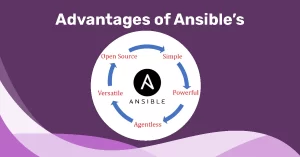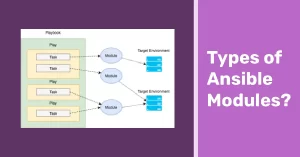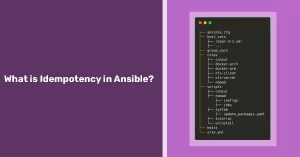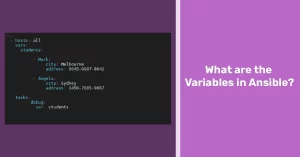Introduction to Ansible Interview Questions
DevOps is attracting considerable interest these days, resulting in greater interest and scrutiny. Ansible is a popular DevOps tool, especially when it comes to software automation. Because Ansible is becoming more popular, it’s only natural that more businesses and organizations are seeking people who have used it before. This is why we’ve put up a list of the most common Ansible interview questions and answers that are asked during an interview.
Ansible enables automation and Configuration Management to appear like a stroll in the park, from automating development systems to setting production environments. I’ve included the most often asked interview questions in this Ansible Interview Questions blog.
If you’ve just attended an Ansible-based interview, please put your interview questions in the comments box and we’ll respond as soon as possible. You may also leave a comment below if you have any questions about what to expect during your Ansible interview.
Beginners Level Ansible Interview Questions

This section of Ansible Interview Questions involves questions that you should be able to answer. These are the most basic Ansible Interview Questions. The interviewer will begin with these and gradually increase the level of difficulty. Let’s take a look at a few of them.
What is Ansible?
Ansible is a software application that automates computer assistance in a simple but effective way. It’s primarily aimed at IT pros, who use it for application deployment, workstation and server upgrades, configuration management, and practically anything else a systems administrator performs on a weekly or daily basis. Ansible is simple to set up since it doesn’t require any agent software and doesn’t require any additional security architecture. These are the most basic Ansible Interview Questions.
What are Ansible’s Advantages?

- It is agentless and simply requires the target machines to have the SSH service functioning.
- Python is the solely needed component, and most computers come pre-installed with the language.
- It just uses a little number of resources, hence it has a low overhead.
- Because Ansible tasks are defined in YAML, they are simple to learn and comprehend.
- Unlike most other tools, which are conventional, Ansible is declarative: you declare the desired state.
These are the most basic Ansible Interview Questions.
What is the relation between CD and CI, and how does Ansible relate to them?
Continuous delivery is a software development practice, while continuous integration is a software development practice. CD allows developers to create programs that can be put into service at any moment. CI, on the other hand, entails each developer contributing integrations on a regular basis (typically daily), resulting in several integrations each day.
Ansible is a great solution for CI/CD procedures because it creates a reliable architecture for configuring the target environment and afterward deploying the application.
How does Ansible work?
This is one of the most common ansible interview questions, in which the interviewer wants to understand if you know the tool inside and out. This is a good place to start because ansible is divided into two types of servers: controlling machines and nodes. The controlling computer has Ansible installed, and the controlled computers administer the nodes through SSH.
The inventory file on the controlling machine specifies the location of the node system. To deploy the modules on the node systems, Ansible executes the playbook on the controlling machine. There’s no need for a third-party program to join the node because Ansible is agentless.
Explore the notion of a “playbook.”
A playbook is a collection of YAML-based files that use scripts to transmit commands to machines. Rather than utilizing individual commands to set up computers from the command prompt remotely, developers may create entire complicated environments by providing a script to the needed systems. Ansible’s main selling point is its playbooks, which are normally known as the tool’s building blocks. These are the most basic Ansible Interview Questions.
What are Ansible Server requirements?
If you’re a Windows user, you’ll need to create a virtual machine and install Linux on it. Python version 2.6 or above is required. If you meet these criteria, you’re set to go! These are the most basic Ansible Interview Questions.
Explain a few of the basic terminologies or concepts in Ansible.
The following are some of the most regularly used words while working with Ansible:-
- Controller Machine
The Controller Machine is in charge of providing the servers under management. It’s the computer on which Ansible is installed.
- Inventory
An inventory is an initialization file that contains information about the many servers you’re in charge of.
- Playbook
A playbook is a YAML-formatted code file. A playbook is essentially a list of actions that must be completed or automated.
- Task
A task is a single operation that must be completed, such as installing a library.
- Module
A module is a collection of operations that can be carried out. Ansible comes with hundreds of built-in modules, however, you may also design your own. - Role: An Ansible role is a pre-defined manner of organizing playbooks and other files in order to make provisioning easier to share and reuse.
- Play: A play is a task that is completed from beginning to end or the execution of a playbook.
- Facts: Facts are global variables that hold system information such as network interfaces and operating systems.
- Handlers are used to change a service’s state, such as restarting or terminating it.
What is Ansible Galaxy?

Galaxy is a site that enables Ansible users to exchange their roles and modules with one another. Ansible includes the Ansible Galaxy command-line tool, which can be utilized to deploy roles through Galaxy or straight from a Source Control Management system like Git. On the Galaxy website, it may also be used to create new roles, delete current ones, and complete tasks.
To get roles through the Galaxy website, type the following command:-
$ansible-galaxy install username.role_name
Compare and contrast Ansible with Chef.
|
Metrics |
Ansible |
Chef |
|
Availability |
Highly available |
Highly available |
|
Ease of setup |
Easy |
Not very easy |
|
Management |
Easy management |
Not very easy |
|
Scalability |
Highly scalable |
Highly scalable |
|
Configuration language |
YAML(Python) |
DSL(Ruby) |
|
Interoperability |
High |
High |
|
Pricing nodes |
$10,000 |
$13,700 |
What are the different types of Ansible Modules?

These are the most basic Ansible Interview Questions. Ansible modules are just a collection of applications that work together to complete a given task. A broad range of jobs may be automated using modules. In Ansible, modules are considered idempotent, which means that sending several identical requests carries the same impact as sending a single request.
In Ansible, there are two sorts of modules:-
- Core modules
These are modules that are maintained by the core Ansible team and will always be included with Ansible. They’ll also get a slight boost in priority for all requests compared to the “extras” repos. Ansible hosts the source code for these modules on GitHub under the Ansible-modules-core repository.
- Extra modules
Currently, these modules are included with Ansible, however, they may be sold individually in the future. The Ansible community is also responsible for the majority of its upkeep. Non-core modules still are completely functional, however response rates for problems and pull requests may be slightly lower. Over time, popular “extras” modules may be upgraded to core modules. Ansible hosts the source for these modules on GitHub under the Ansible-modules-extras repository.
Intermediate Level Ansible Interview Questions

In this section, I’ll be covering the intermediate Ansible interview questions asked by the candidates. These Ansible interview questions will help you ace the interview. These Ansible interview questions are asked if you clear the beginner questions. These questions are asked with the motive of measuring how much knowledge and skill you have for that specific technical skill. Let’s get started.
What exactly is a configuration management tool?
Configuration management software aids in the maintenance of a system’s desirable settings. They aid in the reduction of deployment time and the effort needed to do repeated operations. Chef, Puppet, Salt, and, of course, Ansible are all popular configuration management systems on the market today.
What is Idempotency in Ansible?

Idempotency is a key characteristic of Ansible. It avoids making modifications to the managed hosts that aren’t essential. You can run one or more jobs on a computer as many times as you will need using idempotency, but it won’t affect anything that has already been changed and is running properly. To put it simply, the only modifications made are those that are required and not currently in place.
In the context of Ansible, what are “facts”?
These are the intermediate Ansible Interview Questions. Facts are recently discovered and well-known system variables that can be found in playbooks and are mostly utilized to create conditional executions. In addition, they collect ad-hoc system data.
You may acquire all the information you need by running the following command:-
|
Command to get all fact |
$ ansible all- m setup |
How can you create encrypted files with Ansible?
Use the ‘ansible-vault create’ command to generate an encrypted file.
$ ansible-vault create filename.yaml
You’ll be prompted to establish a password, which you must then confirm by typing it again. You’ll have access to the new file in which you may add and change information.
What are the Variables in Ansible?

These are the intermediate Ansible Interview Questions. Ansible variables are identical to variables in other programming languages. An Ansible variable, like every other variable, is given a value that is used to create playbooks. Around the variables, you may also apply conditions. Here’s an illustration:
– hosts: your hosts
vars:
port_Ana : 8080
We’ve created a variable named port Ana and given it the port number 8080. In the Ansible Playbook, such a variable can be utilized.
What’s the distinction between the variable name and the environment variable?
These are the intermediate Ansible Interview Questions and the differentiation between Variable Name and Environment Variable:
|
Variable Name |
Environment Variable |
|
|
Could you describe what Ansible playbooks are? Give some examples to illustrate your point.
These are the intermediate Ansible Interview Questions. Ansible playbooks are authored mostly in YAML format. It’s a data serialization language that can be read by humans. It’s a popular format for configuration files. It may also be used to store data in a variety of applications. Almost every YAML file in Ansible begins with a list. Every item inside the list is a key/value pair list, often known as a “hash” or “dictionary.” As a result, we’ll need to know how to build YAML lists and dictionaries.
A list’s members are all lines that start with a “- ” and end with about the same indent level (dash and space). More complex data structures, like lists of dictionaries or mixed dictionaries with lists or a combination of both, are feasible. If you really want a playbook with information on the United States, for example:-
-USA
-continent: North America
-population: 319 million
What are Ansible Vaults and why are they used?
Ansible Vault is a tool that enables you to securely store all of your secrets. It has the ability to encrypt whole files, YAML playbooks, and even a couple of variables. It has a feature that allows you to encrypt sensitive data as well as incorporate it into your playbooks.
Vault uses file-level granularity, with files that are either completely encrypted
or completely unprotected. Ansible Vault is particularly user-friendly since it utilizes the same passwords for encrypting and decrypting data.
What is Ansible Tower?
These are the intermediate Ansible Interview Questions. Ansible Tower is a more enterprise-focused version of Ansible. It’s a web-based management system with a simple user interface that includes dashboards with all the state summaries for all of the hosts, rapid deployments, and configuration monitoring.
The tower logs all operations, manage inventories graphically, and syncs them with a number of cloud providers while allowing you to exchange SSH credentials without revealing them.
How do you maintain confidential information in a playbook?
While using the -v (verbose) option, you may use the following task to prevent the output or command passed to a job from being displayed:-
|
Command |
– name: secret task shell: /usr/bin/do_something –value={{ secret_value }} no_log: True |
This may be used to keep the output verbose while hiding important information from people who would otherwise want to view it. The no_log attribute can likewise be used to refer to a full play:-
|
Command |
– hosts: all no_log: True |
Advanced Level Ansible Interview Questions

In this section of Ansible interview questions, I have covered the following advanced level Ansible Interview Questions and answers.
How can you create a LAMP stack and deploy a webpage by using Ansible?
You will answer these Ansible Interview Questions by diving the flow into the steps. The answer to the above Ansible Interview Questions. If you’re attempting to install a site on 20 different systems, you’ll need a base OS, web server, MySQL, and PHP for each one. To install such dependencies on all 09 computers at once, we use ansible-playbook.
You may require two virtual machines for this issue statement: one of these as a server where many Ansible is installed, and the other as the remote host. I’ve also constructed a basic static webpage under the index folder, which consists of two files: index.html and style.css.
I’ve constructed a single Ansible playbook to install Apache, MySQL, and PHP in the code below:-
|
— # Setup LAMP Stack – hosts: host1 tasks:
– name: Add ppa repository become: yes apt_repository: repo=ppa:ondrej/php
– name: Install lamp stack become: yes apt: pkg: – apache2 – mysql-server – php7.0 – php7.0-mysql state: present update cache: yes
– name: start apache server become: yes service: name: apache2 state: started enabled: yes
– name: start mysql service become: yes services: name: mysql state: started enabled: yes
– name: create target directory file: path=/var/www/html state=directory mode=0755
– name: deploy index.html became: yes copy: src: /etc/ansible/index/index.html dest: var/www/html/index/index.html |
There are now six core duties, each of which serves a distinct purpose:-
- The first job adds the MySQL and PHP repositories that are necessary for installation.
- The second process involves setting up apache2, MySQL, PHP, and PHP-MySQL.
- The Apache & MySQL services are started in the 3rd and 4th tasks, respectively.
- The fifth job establishes a target directory on the host system, and the sixth task runs the index.html file, retrieving it from the server and copying it to the host machine.
Finally, use the following code to run this playbook:-
|
$ ansible-playbook lamp.yml -K |
How can you set the PATH variable for a job or any other environment variable?
The ‘environment’ keyword can be used to set environment variables. It may also be configured for a single task or a whole playbook. To demonstrate how to look at the code excerpt below:-
|
environment: PATH: “{{ ansible_env.PATH }}:/thingy/bin” SOME: value |
What’s the correct method to upgrade Ansible?
It’s simple to upgrade Ansible. Simply type this command.
|
sudo pip install ansible== |
Assume you’re configuring the production environment with Ansible, and your playbook utilizes an encrypted file. Passwords must be entered while using encrypted files. Can this procedure be automated, though, given Ansible is utilized for automation?
Yes, Ansible has a password file function that allows you to preserve all of the passwords for your encrypted files. As a result, whenever the user is prompted for a password, he may simply call the password file. Ansible reads and enters the password automatically. You can use this command:-
|
$ ansible-playbook launch.yml –vault-password-file ~/ .vault_pass.txt |
How can you use Ansible to connect to other devices?
An inventory file is produced after Ansible is deployed on the controlling computers. The link between other nodes is specified in this inventory file. A basic SSH connection may be established. The ping module can be used to test a connection to a separate device. The command verifies that all of the nodes in the inventories file are connected.
|
ansible -m ping all |
Conclusion
Beginner Ansible Interview Questions, Intermediate Ansible Interview Questions, and Advanced Ansible Interview Questions have all been covered in this article. I hope this article has provided you with a better understanding of the different sorts of DevOps and Ansible interview questions and how to answer them.
Frequently Asked Questions
Based on a known file structure, roles allow you to load associated variables, jobs, handlers, or other Ansible artifacts automatically. After you’ve organized your material into roles, you can quickly reuse and share it with others. For more information on Ansible, read this blog on Ansible Interview Questions.
TCS relies on the Red Hat® Ansible® Automation Platform to automate modernization and migration operations, reduce risk, and speed up the transformation process. For more information on Ansible, read this blog on Ansible Interview Questions.
Ansible is a configuration management and automation tool that is both easy and powerful. Ansible is mostly used for bridge computer support automation. For more information on Ansible, read this blog on Ansible Interview Questions.
4. What are the modules in Ansible?
Modules are small pieces of code that may be run from the command prompt or utilized in a playbook activity. Ansible runs each module and gathers the results, generally on the remote administered node. Most modules in Ansible 2.10 & higher are stored in collections.
5. What are handlers in Ansible?
In a nutshell, a handler is specific activities that are only run when the notify directive is activated. Once all tasks have been completed, controllers are conducted at the end of the play. Handlers are commonly used in Ansible to launch, restart, reboot, and terminate services. For more information on Ansible, read this blog on Ansible Interview Questions.
6. What variables are Ansible?
Variables are used by Ansible to handle system differences. With Ansible, users can use a single command to run jobs and playbooks on numerous platforms. You may use normal YAML syntax to build variables, such as lists and dictionaries, to express the differences between those multiple systems. For more information on Ansible, read this blog on Ansible Interview Questions.
On many systems that come with Python 3, Ansible will immediately recognize and use it. Set the ansible python interpreter inventory variable to the address of a Python 3 interpreter at a group or host level to specifically set up a Python 3 interpreter. Like as /usr/bin/python3. For more information on Ansible, read this blog on Ansible Interview Questions.
Yet Another Markup Language (YAML) is an acronym for Yet Another Markup Language. Ansible’s playbooks are one of its most important aspects, as they inform it on what to do. They’re similar to a to-do list for Ansible, with a list of tasks. Playbooks are a collection of actions that a user wishes to run on a certain computer. Playbooks are executed in order. For more information on Ansible, read this blog on Ansible Interview Questions.
For the same reasons as other configuration management systems, it’s worth utilizing. It’s far preferable to utilize templates and version control, as well as the ability to recreate things from scripts you trust. For more information on Ansible, read this blog on Ansible Interview Questions.
10. What is static inventory in Ansible?
A static inventories file in Ansible is a simple text file with a list of controlled hosts specified under a host population using either domain names or IP addresses. The name of the host group is surrounded in square brackets. The controlled host entries are listed after the group name, one by one, on separate lines. For more information on Ansible, read this blog on Ansible Interview Questions.













